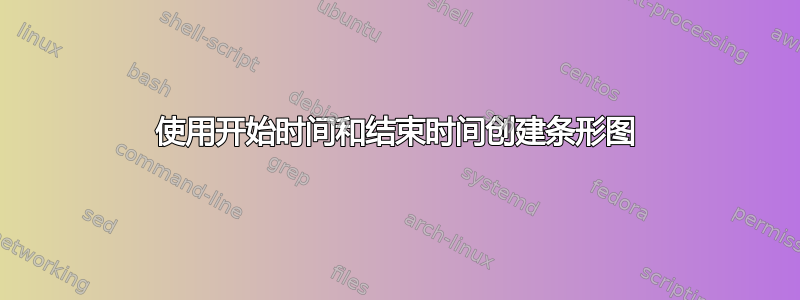
答案1
实际上不能用条形图来做到这一点,但是如果您想要填充区域,则需要从下面的方法开始,然后变得复杂。
您可以将数据重新排列成三个单独的块,如下所示。选择第一个块,然后插入 XY 散点图。选择并复制第二个块,选择图表,然后使用选择性粘贴将数据添加为新系列,系列名称在第一行,X 值在第一列。对第三个块重复此操作。经过一些格式化,它看起来像下面的图表。
或者,您可以将数据重新排列成一个块,并在各部分之间留出一些空白行。创建 XY 散点图并进行格式化。
您可以从这里下载我的工作簿:带开始和结束时间的条形图.xlsx
编辑:使用 VBA 方法来安排数据。
我编写了一个 VBA 例程,它从下面屏幕截图中的第一个块之类的数据开始,进行最低限度的验证(它是否有三列,是否有标题行),询问用户需要哪个输出(每行一个系列或所有行合计一个系列),询问用户将输出放在哪里,然后生成适当的输出。输出单元格链接到输入单元格,因此如果用户更改输入范围内的值,输出值将反映更改。
它的文档很少,欢迎提问。
用户首先选择输入范围(或输入范围中的一个单元格)并运行代码。
运行代码后,用户只需选择输出范围(或输出范围中的一个单元格),然后插入带有线条而没有标记的 XY 散点图。
以下是 VBA 程序:
Sub Reformat_StartTimeCount_OneSeries()
If TypeName(Selection) <> "Range" Then
MsgBox "Select a range of data and try again.", vbExclamation, "No Data Selected"
GoTo ExitSub
End If
' input range: three columns (start, end, count), one row box, maybe header row
Dim InputRange As Range
Set InputRange = Selection
If InputRange.Cells.Count = 1 Then
Set InputRange = InputRange.CurrentRegion
End If
If InputRange.Columns.Count <> 3 Then
MsgBox "Select a three-column range of data and try again.", vbExclamation, "No Data Selected"
GoTo ExitSub
End If
' one or multiple colors
Dim Question As String
Question = "Do you want one series (one line color) for each row of data?"
Question = Question & vbNewLine & vbNewLine & "(Yes for multiple colors, No for one color)"
Dim Answer As VbMsgBoxResult
Answer = MsgBox(Question, vbQuestion + vbYesNo, "How Many Lines")
If Answer = vbYes Then
Dim MultipleSeries As Long
MultipleSeries = 1
End If
' ignore header row
If Not IsNumeric(InputRange.Cells(1, 3)) Then
Dim HasHeaderRow As Boolean
HasHeaderRow = True
With InputRange
Set InputRange = .Offset(1).Resize(.Rows.Count - 1)
End With
End If
' how many rows?
Dim RowCount As Long
RowCount = InputRange.Rows.Count
' build array of formulas
Dim OutputArray As Variant
ReDim OutputArray(1 To RowCount * (5 - MultipleSeries) + MultipleSeries, 1 To 2 + MultipleSeries * (RowCount - 1))
Dim RowIndex As Long
For RowIndex = 1 To RowCount
Dim RowBase As Long, ColumnBase As Long
RowBase = (RowIndex - 1) * (5 - MultipleSeries)
ColumnBase = 2 + MultipleSeries * (RowIndex - 1)
If MultipleSeries Then
If HasHeaderRow Then
OutputArray(1, ColumnBase) = "=" & InputRange.Cells(0, 3).Address(False, False) & "&"" " & RowIndex & """"
Else
OutputArray(1, ColumnBase) = "Count " & RowIndex
End If
Else
If RowIndex = 1 Then
If HasHeaderRow Then
OutputArray(RowBase + 1, 2) = "=" & InputRange.Cells(0, 3).Address(False, False)
Else
OutputArray(RowBase + 1, 2) = "Count"
End If
Else
OutputArray(RowBase + 1, 2) = "#n/a"
End If
End If
OutputArray(RowBase + 2, 1) = "=" & InputRange.Cells(RowIndex, 1).Address(False, False)
OutputArray(RowBase + 3, 1) = "=" & InputRange.Cells(RowIndex, 1).Address(False, False)
OutputArray(RowBase + 4, 1) = "=" & InputRange.Cells(RowIndex, 2).Address(False, False)
OutputArray(RowBase + 5, 1) = "=" & InputRange.Cells(RowIndex, 2).Address(False, False)
OutputArray(RowBase + 2, ColumnBase) = 0
OutputArray(RowBase + 3, ColumnBase) = "=" & InputRange.Cells(RowIndex, 3).Address(False, False)
OutputArray(RowBase + 4, ColumnBase) = "=" & InputRange.Cells(RowIndex, 3).Address(False, False)
OutputArray(RowBase + 5, ColumnBase) = 0
Next
' output formulas
Dim OutputRange As Range
On Error Resume Next
Set OutputRange = Application.InputBox("Select the top left cell of the output range.", "Select Output Range", , , , , , 8)
On Error GoTo 0
If OutputRange Is Nothing Then GoTo ExitSub
With OutputRange.Resize(RowCount * (5 - MultipleSeries) + MultipleSeries, 2 + MultipleSeries * (RowCount - 1))
.Value2 = OutputArray
.EntireColumn.AutoFit
End With
ExitSub:
End Sub
我已上传了新的练习册,其中包含答案的两个部分。请在此处下载:带开始和结束时间的条形图.xlsm








